by NEIL SINYARD
Writer: Gwyneth Hughes; Based on (book): Donald Spoto, Spellbound by Beauty; Producer: Amanda Jenks; Director:Julian Jarrold
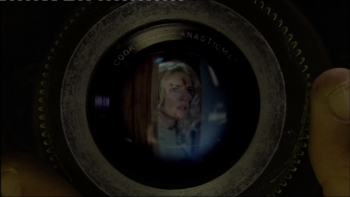
There is a compelling moment in Strindberg’s The Father when a doctor is recalling a production of Ibsen’s Ghosts and being dismayed by Mrs Alving’s vilification of her late husband. ‘I thought to myself,’ says the Doctor, ‘What a damned shame the fellow’s dead and can’t defend himself!’
I felt a bit like that whilst watching the BBC/HBO production The Girl,1 Julian Jarrold’s film about the deteriorating relationship between Alfred Hitchcock and his new discovery Tippi Hedren during the making of The Birds (1963) and Marnie (1964). Dramatic characterisation comes perilously close to character assassination. Jarrold’s previous TV piece, the award-winning Appropriate Adult, was also rooted in reality and had certainly confirmed his aptitude for exploring the dark side of human personality; and The Girl is a powerful and progressively harrowing film about sexual harassment, psychological cruelty, and the abuse of power.2 I think the two leading performances are superb. Toby Jones’s mimicry of Hitchcock is masterly, but he also probes to the melancholy behind the façade; and Sienna Miller likewise conveys a tough and courageous resilience beneath the actress’s surface elegance. At the outset, however, the film claims to be based on extensive research (though there is no mention of Tony Lee Moral’s richly detailed book on the making of Marnie3 ) and thus is purporting to be an accurate account of events. On the level of veracity rather than drama, the film becomes more problematic.
Gwyneth Hughes’s screenplay acknowledges Donald Spoto’s book, Spellbound by Beauty as its major source.4 Hitchcock scholars will know that this was Spoto’s third book on the director, following his genuinely insightful critical appraisal of the films and a contentious and controversial Hitchcock biography, Dark Side of Genius.5 I’m tempted to see it as a trilogy of disillusionment, in which an author finds his idol has feet of clay and endeavours to destroy what he set out originally to honour. It reminded me of a lovely moment in Barbara Leaming’s biography of Orson Welles,6 when Welles muses on a possible movie about a biographer who, having begun in all innocence and enthusiasm, ends up shooting his subject: and I sometimes think that Spoto has done the equivalent of that with Hitchcock. In other ways he calls to mind a biographer like Norman Sherry who has done three volumes of biography of Graham Greene. When you’ve spent half your life in the study of a single personality, I suppose you inevitably become very possessive of your subject, to whom, you must feel, you alone hold the key. Like Sherry, Spoto pushes a particular line of interpretation that is seductive and partially persuasive but does not (and indeed could not) tell the whole truth. So subtleties and nuances tend to be erased from the scene; insinuation takes the place of information; hypotheses harden into allegation; and, in this case, a complex and disturbing human story is reductively summarised in the Radio Times by Alison Graham (admittedly, not the most sophisticated of critical commentators) as the tale of, quote, ‘an old perv… [who] after being rejected repeatedly by Hedren, becomes sadistic towards his star, making sure she’s pecked by real birds’.7 Hitchcock and Hedren deserve better than that; so, for that matter, does The Girl, but it could have done more, I feel, to avoid laying itself open to such crude characterisation.
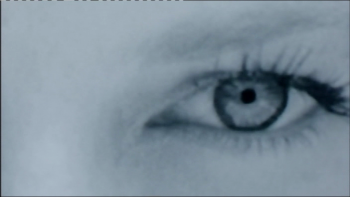
The Girl begins well, with a concise evocation of period (the early 60s) and of the mystique of film-making (a telling close-up of the eye makes one think of Psycho: throughout Jarrold tucks in frequent allusions to Hitchcock’s sense of colour and composition without their becoming laboured or simply imitative). Hedren’s arrival at the studio for her meeting with Hitch is wittily similar to the arrival of Melanie at Bodega Bay in The Birds (the nervous excitement of a young woman in a strange environment anticipating a mysterious assignation). Their first meeting over lunch, where Hitchcock serves a red wine known as the ‘Heartbreak Grape’, has intimations of things to come, particularly when the scene concludes with a sexually suggestive limerick, of which the man had an apparently inexhaustible store. I wondered if the ominous tone was being established too early, to the detriment of credibility and of Hitchcock’s courtesy and comedy. He is soon to say, ‘As is well known, I have no sense of humour,’ which the remainder of the film will confirm, but the real Hitchcock would surely have said that as a joke, particularly if one recalls his persona for his TV shows; indeed, he once told a National Film Theatre audience (jokingly) that ‘every film I make is a comedy’.8 I’ve always loved his response to a journalist at the Cannes press conference after the screening of The Birds. ‘How did you get the birds to act so well?’ he was asked. ‘They were very well paid,’ he replied.
The screen test scene seems a little sensationalised compared with the visual evidence one has seen elsewhere (was Hedren actually instructed to give her screen partner, Martin Balsam a passionate kiss, as she is here?).9 However, the scene in the restaurant, where Hitchcock, in the presence of his wife Alma (Imelda Staunton), uses a gift of a bird-shaped brooch to tell her she has been cast in the leading role, is genuinely touching and apparently close to what actually occurred. Hitchcock is also shown explaining and rehearsing a scene with his new, relatively untrained star. He did spend hours with Tippi Hedren going over her roles and she has always expressed gratitude for what she learned from him. The recorded tapes of their discussions on the role of Marnie, for example, suggested complete professionalism on both sides rather than (as suggested in The Girl) sublimated passion on one.
We are moving towards what for me is one of the most troublesome scenes in the film, because it is clearly intended to set up much of what follows, and yet it fails to convince. Being driven to the location, Hitchcock clumsily attempts to force his attentions on Hedren and she has to resist his assault and escape from the car. Did this actually happen? I don’t know. In the ‘Making of’ featurette on the DVD, Julian Jarrold asserts that Hitchcock began making sexual advances towards Hedren midway through the shooting of The Birds,10 but this is contradicted by the most authoritative of recent Hitchcock biographers, Patrick McGilligan, who has written about the making of The Birds that ‘no one had noticed any signs that the director was obsessed with his leading lady, that Hitchcock had fallen in love with Hedren…nor is there any evidence that he treated her with deliberate cruelty.’11 Jay Presson Allen, who replaced Evan Hunter as screenwriter on Marnie and became a good friend of Hitchcock, is on record as saying that ‘he would never in one million years do anything to embarrass himself.’ One could allow for an element of dramatic licence, but, even in the context of the film, the scene seems implausible. If he were intent on making sexual advances to Miss Hedren, one would have thought he would have chosen a better place and time than in the back of a limousine in full view of the driver’s mirror and within sight of the film’s location and crew. Also, if he is misbehaving so early, why didn’t Hedren walk away from the situation then? The question is raised later but never answered.
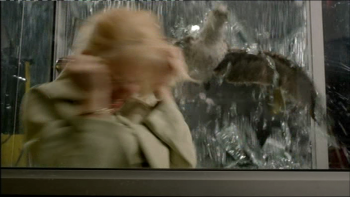
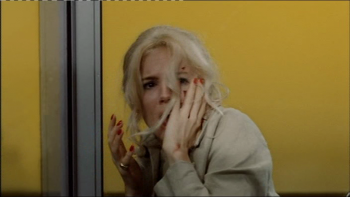
The phone booth: The Girl (two images above) and The Birds (two images below)
I would speculate on two reasons for the scene, if it is not authenticated by other evidence. One is, the screenwriter might have been following (or directed to follow) that screenwriting manual directive that a script should have some sort of decisive turning-point after about twenty minutes or so in order to sustain an audience’s interest. (This might be in Robert McKee’s Story, but as that book talks about screenwriting without even mentioning Billy Wilder, or a perfect screenplay like The Apartment, one would be justified in ignoring that advice.) The second reason is to motivate what follows, which is the revenge of the director for the rejection. Unfortunately, if the originating scene doesn’t work, then it’s not likely that what follows will either. In the phone-booth scene, where the heroine is trapped whilst the birds are supposedly marauding outside, one of the props malfunctions, shattering the glass and causing cuts to the actress’s face. Was it an accident? Everything in the way the scene is filmed, from Hitchcock’s intimidating presence that makes the actress tremble to the insistent close-ups of his face prior to the incident, suggests that it is a deliberate ploy of the director to terrorise the star. Yet it seems quite incredible that a director would risk jeopardising his own film by deliberately injuring his leading actress in a perverse endeavour to obtain her obedience.
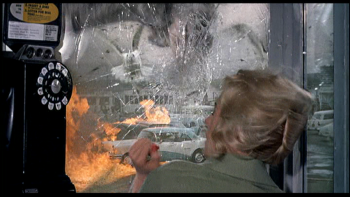
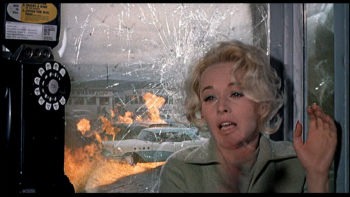
This is taken to an extreme in the notorious attic scene, where Melanie is attacked and almost killed by the birds and where Hitchcock took five days to shoot the scene, using real birds rather than the dummy ones that Hedren had been expecting. It is true that the scene caused Hedren (and Hitchcock, as even Spoto acknowledges) much distress and that production had to be postponed until she had recovered from her ordeal. But to imply, as The Girl does, that Hitchcock sadistically and deliberately prolonged the shooting as further stages in his revenge or demonstration of power seems dubious, to say the least. Hitchcock undoubtedly appreciated the importance of the scene; it was the film’s dramatic climax and if it didn’t work, then the whole film would be severely diminished. (For the same reason, he had taken seven days over the shooting of the much shorter shower-murder sequence in Psycho, because he recognised its centrality: if that scene failed to deliver, then the whole film would go down the drain, as it were.) This is not necessarily condoning his methods, of course (though they are far from unprecedented in the behaviour of movie directors) but is simply to explain the reason behind the lengths he went to: it was for the benefit of the film not for the punishment of its leading lady. Indeed Tippi Hedren herself made the shrewd observation that it was probably that one scene which had prompted Hitchcock to seek out an unknown for the leading role in the first place: he knew that an established star would have balked at it.
Incidentally, contrary to the suggestion in The Girl, Tippi Hedren had not been cast in the title role of Marnie whilst The Birds was still in production. This further undercuts the notion that Hitchcock at that stage was already infatuated with his leading lady. His preference all along had been for Grace Kelly in a comeback role, but when she finally declined the role out of obeisance to her royal responsibilities, Hitchcock did not (as he is shown doing in The Girl) immediately offer the role to Hedren, but contemplated and even tested other actresses before making up his mind. According to Patrick McGilligan, the casting of Hedren was ‘almost circumstantial’: she happened to be around, and available, and, he thought, capable.
In The Girl, before Marnie has actually started shooting, there is a brief, interesting exchange between Alma and Hitchcock’s formidable personal assistant, Peggy Robertson (Penelope Wilton), who was the guardian of all Hitchcock’s business and personal arrangements and whom even the fearsome Bernard Herrmann, I was once told, ‘was wary of’. They are wondering what it is that enthrals Hitchcock so much about Hedren and that distinguishes her in his eyes from the other glamorous blondes he has directed- Madeleine Carroll, Joan Fontaine, Grace Kelly, Eva-Marie Saint etc. ‘Whatever he throws at her,’ Peggy says, ‘she makes him feel he can’t hurt her.’ It is not a very satisfactory explanation and not one that is borne out by the film. One of the disappointments of The Girl is the supporting characterisation. The actors are well cast and the parts are well played, but key questions remain unanswered. Why didn’t Alma intervene? She knows what is going on and is obviously disturbed by it, and she deserves more space and attention for her point of view. Similarly, what did Peggy Robertson make of it? Why is she so conciliatory on Hitchcock’s behalf? At one point in the film, Hitchcock is unpardonably rude to her, to the point of reducing her to tears, but she remains fiercely supportive. Hitchcock tended to surround himself with female assistants who became long-serving members of his staff and devoted to him, but there is little suggestion here of why he inspired that loyalty. A dimension is missing.
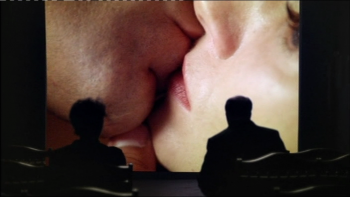
The Marnie section in The Girl seems on surer factual ground than The Birds, at least in the sense that it is generally agreed that there was, towards the ending of the filming, a massive falling-out between director and star. Hitchcock’s first official biographer, John Russell Taylor, when asking the director about this, was told that she had said something that no one was allowed to say. When Taylor pressed him further, Hitchcock replied: ‘She referred to my weight.’ Taylor took that to mean that she had called him a ‘fat pig’ or something of that order, and certainly one of the things that The Girl legitimately stresses is Hitchcock’s sensitivity about his physical appearance and what Toby Jones in the DVD ‘Making of’ documentary called Hitchcock’s ‘self- loathing of his own body.’ (I have always been saddened and rather moved by Hitchcock’s description of himself as a boy as ‘a remarkably unattractive child,’ and wondering who had made him feel that way about himself.) What specifically prompted Hedren’s outburst, though, and how far Hitchcock’s sexual harassment went, has been widely debated. In The Girl, there is a declaration of love, instantly rejected, leaving Hitchcock to fantasise about a reciprocal response before staring out at the camera, as if he is seeing a grotesque reflection of himself. After a forlorn telephone conversation with Hedren at Christmastime, part of which has been overheard by his wife, Hitchcock is told by Alma that he’d run a mile if the girl did offer herself to him. In a final scene in his office, he asks for sexual favours in return for what he has done for her. Was that the case? If so, one cannot imagine his harbouring much anticipation of success or being surprised by her rejection: the scene is chilling in its lack of romance.
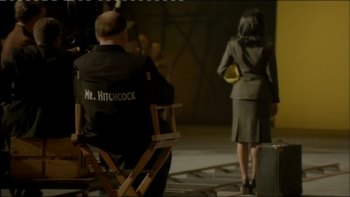
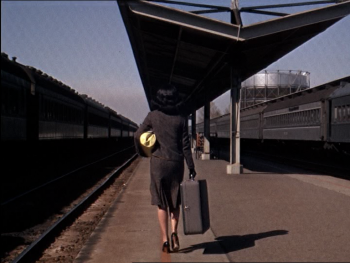
The Girl concludes with a fine reconstruction of the opening shot of Marnie (one of the cinema’s all-time great openings) and the implication that, for Hedren, this is the end of the nightmare. One of the final captions of the film mentions that they never worked together again; and certainly one of Hitchcock’s most indefensible acts in this saga was his refusal to release her from her seven-year contract, which effectively sabotaged the development of her acting career. It might be worth recalling, though, that their communication was not as final as the film makes out. They did meet informally several times in the year after the Marnie experience, and Tippi Hedren was sufficiently un-embittered to attend the Life Achievement Award ceremony for Hitchcock at the American Film Institute in 1979, a year before his death.
The other caption at the end of The Girl states, perhaps argumentatively, that ‘Marnie is now hailed as Hitchcock’s final masterpiece.’ Some (not me) would make that claim for the later Frenzy. Others (not me) would dispute that Marnie is a masterpiece at all. Even its screenwriter Jay Presson Allen thought its later high reputation undeserved. In a recent article in The Guardian,12 Alex von Tunzelman wrote that ‘Marnie is a terrible movie and a cruel one: the idea that a woman sexually traumatised by her childhood can be saved by submitting to a controlling rapist, is offensive, as well as plain wrong.’ That bizarre oversimplification of the movie (a rough dramatic equivalent would be to say that Othello is fundamentally a play about a man who murders his wife because he thinks she’s misplaced his handkerchief) is, one hopes, the most extreme example of the misapplication of Hitchcock’s characterisation in The Girl to a reading of his films. The greatest of all Hitchcock critics, Robin Wood suggested provocatively that Marnie was a test-case: if you didn’t like it, then you didn’t really like Hitchcock; and if you didn’t love it, then you couldn’t love cinema.13 In the 1980s Wood was worrying about whether Hitchcock could be rescued from feminist rage.
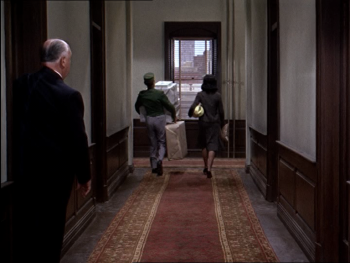
“his men are fully implicated in the deed”: Hitchcock and the gaze in Marnie

In fact, one of the interesting things about Hitchcock criticism after the first wave of auteurism was the defence of his films by feminist film critics, for example, Camille Paglia on The Birds,14 and the trail-blazing Molly Haskell on Marnie, which she described as ‘one of his most disturbing and, from a woman’s point of view, most important films….If Hitchcock’s women must be tortured and punished, his men are fully implicated in the deed- and the more detached they seem, the more guilty and morally responsible.’15 In other words, according to Haskell, the films are as much a critique of the male desire to dominate as they are visions of the victimisation of the female; and the opening scenes of Marnie, for example, very eloquently suggest the heroine’s kleptomania as her revenge on patriarchy, and subtly delineate how far she can operate in a male-dominated world whilst still retaining her financial and sexual independence.16 There are no token females in Hitchcock’s films or women who are there simply as ‘love interest’. They are invariably there as strong characters in their own right, and only Cukor, Ophuls and Wyler (I have problems with Hawks) can consistently match Hitchcock for complexity of female characterisation during the heyday of Hollywood’s Golden Age. One of the most interesting aspects of both The Birds and Marnie is the prominence of the feminine perspective. In The Birds women are the drivers of the plot, and the male characters are fairly marginal; in Marnie, the women are at least as important as the men.
In Marnie, it is well known that the honeymoon scene caused a rift between the original writer Evan Hunter and Hitchcock (though it is intriguing that Hunter’s female replacement, Jay Presson Allen had no problem with it). The scene is given appropriate prominence in The Girl, and Hunter’s unease about Hitchcock’s visual presentation (Hitchcock’s insistence that the camera be on the heroine’s face at the moment of intercourse) is dutifully reported and that moment replicated. Hunter seemed to interpret Hitchcock’s strategy as the sadistic relish of a male chauvinist, but it is possible to see it in exactly the opposite way and suggest that Hitchcock wanted at this point to emphasise Marnie’s feelings of horror and desolation. (She is, after all, to follow the experience with an attempt at suicide.) Certainly the character of Marnie (the repression, the private fears beneath the level of the conscious mind, the sublimation of her sexuality) seems much closer to that of Hitchcock’s personality than does the virile, self-confident hero played by Sean Connery (‘in a brilliant performance’ says Molly Haskell, and I agree). This could suggest a degree of empathy between title character and director. In this regard, Hitchcock could be seen as more masochist than misogynist- that is, he puts himself through his heroine’s pain- and that the power of his films comes not from the display of his sadism but from the intensity of his sympathy. An equally important scene in Marnie, which is not referenced in The Girl, is a later ‘free association’ session between husband and wife, which Marnie significantly initiates but then has to retreat in terror as the responses threaten to penetrate her defences: she ends up crying, ‘Oh help me, please God, somebody help me!’ In their lengthy discussion of the scene, Hedren remarked to Hitchcock, ‘It’s a very sad scene, isn’t it?’, to which he replied, ‘Yes, but it comes out of anger…’. It is a very suggestive comment. Marnie’s rage at her repression and her feeling of imprisonment within her own body could easily correlate to Hitchcock’s own feelings.
The making of The Birds and Marnie is a sad tale overall- except for the movies themselves. Tippi Hedren came through the experience with dignity whereas Hitchcock emerged from what he described to Truffaut as ‘the emotional siege I went through’ with far less credit; but I was surprised by Julian Jarrold’s description of the films in the DVD featurette as ‘artificial and old fashioned’ for today’s audiences and representing a ‘decline as a style of film-making’. The truth is that the two films continue to provoke extensive discussion and analysis: for their stylistic experimentations that often veer towards surrealism and expressionism; for their generic elusiveness, suspense set-pieces, and open endings; for their thematic boldness on issues such as repression, frigidity, memory and child abuse; for the complexity of their sexual politics; for the astounding imagery that finds visual correlatives for emotional states; and much else besides. Moreover, Hitchcock’s stock has never been higher, what with two films and a play (by Terry Johnson) about him currently in circulation as I write; more books about him and his work by far than about any other film director; and his most personal movie, Vertigo (widely dismissed on first release) recently being voted in an international survey of critics as the best film ever made. He would undoubtedly have been gratified by this, as he came to regret the droll, podgy joker persona he had adopted for his TV series, because he thought it obscured his true achievement as a film artist. Ironically, the public persona has become less likeable as the recognition of artistic stature has increased, though Hitchcock, in his defence, could no doubt have cited many cases of mistreatment by directors of their stars (Preminger, Lang, Powell, Ford, Kubrick etc. etc.) in their exertion of power for the benefit of their films. It might even go with the pressures of the job. As William Wyler once commented to Charlton Heston, ‘Believe me, , but you don’t make good movies that way.’
Citizen Kane probably had the best idea for cine-biography. Take a great person as subject; have a wealth of contradictory accounts from people who claim to have known him or her really well; and then at the end, undercut all this evidence by revealing something (ideally from childhood) that none of the witnesses knew about or ever will know; and suggest that this might prove the key to the whole personality- or, then again, probably not. In other words, respect the mystery. Hitchcock’s films probably tell you more about his character than his biographies: they are the dreams in the dark of a very complex man. I think he would have endorsed what Orson Welles once told an interviewer: ‘My work is what enables me to come out of myself. I like what I do, not what I am. Do you know the best service anyone could render to art? Destroy all biographies. Only art can explain the life of a man and not the contrary.’17
You may be interested in visiting this new website compiling some of Neil Sinyard’s writing on film and other topics, our new sister site.
Originally posted: 31 January 2013.18

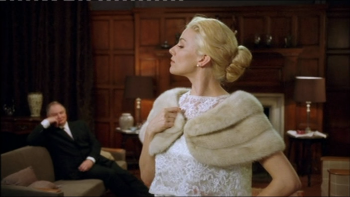
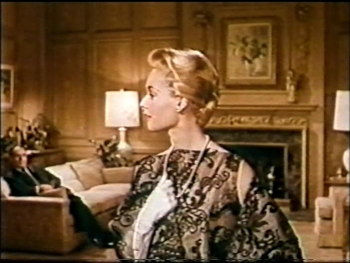
Pingback: Juggling Wolves: BFI Film Classics: Marnie | Neil Sinyard on Film
Pingback: The Girl one of 2012′s Biggest Movie Controversies | save hitchcock